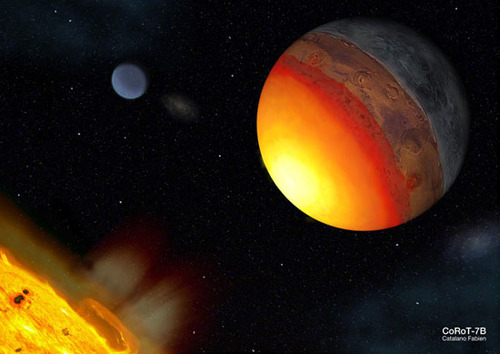Just for fun, scientists vaporize the Earth in a simulation

One day, a long long long time from now, the Sun will expand to many times its current size, engulfing the inner planets, including our own Earth, vaporizing our atmosphere and rocks and trees and cute baby deer. What will that look like? Some astronomers at Washington University St. Louis decided to find out.
So besides for funsies, what’s the point of pretending to vaporize the Earth? Well, when astronomers spot an exoplanet, there are just a limited number of things that we can find out about it from here. We can usually determine its mass and its density, and if we get really lucky and we can spot the planet passing in front of its star, we can sometimes get a hint about what the atmosphere is composed of. That doesn’t help us figure out what the planet is made of, though, since the surface is buried underneath atmosphere anyway.
Astronomers have started looking at exoplanets that are very close to their parent stars to try to determine their compositions. These planets are so close in that they’re actually being vaporized by the heat, and this vapor from the surface gets mixed into the atmosphere which, if we’re lucky, we can detect. In order to determine surface composition from atmospheric composition, though, we have to know the relationship between the two, which is where the modeling comes in. And what better way to model an Earth-like composition than by slowly vaporizing Earth in simulation and seeing what happens?
One of the most interesting outcomes of this simulation is that when researchers ran it on a more primal version of Earth, the resulting atmosphere included both methane and ammonia. And as you know, when you add energy to a mix of methane and ammonia (by way of lightning or ultraviolet light), you get amino acids, which is what DNA is made out of. Yeah, we’re not saying it’s aliens, but there’s a possibility that it’s definitely aliens.
The end of the press release from Washington University St. Louis includes this gem, from planetary scientist Bruce Fegley:
Asked whether his team ever cranked the temperature high enough to vaporize the entire Earth, not just the crust and the mantle, Fegley admits that they did. “You’re left with a big ball of steaming gas that’s knocking you on the head with pebbles and droplets of liquid iron,” he says. “But we didn’t put that into the paper because the exoplanets the astronomers are finding are only partially vaporized,” he says.




Notes